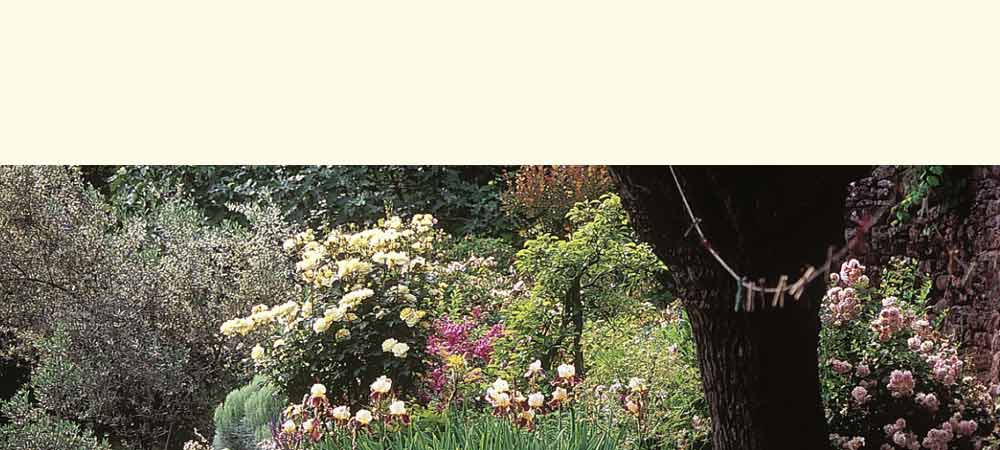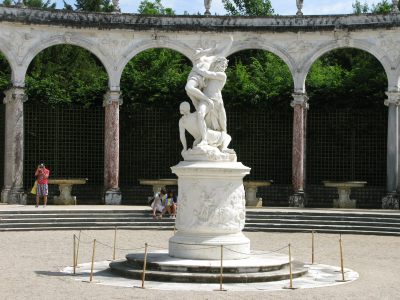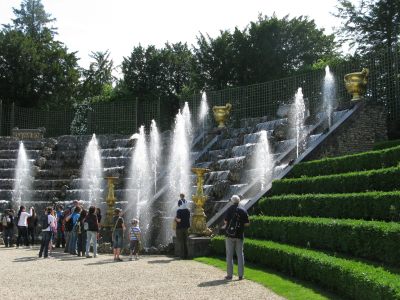- Discoveries (3)
- Events (3)
- Mediterranean notes (3)
- Perspectives on country living (1)

MEDITERRANEAN LANDSCAPE ART
Versailles and the Villa d'Este
Serendipity, my guide in many things, took me in May to the Villa d’Este near Rome and just a few weeks later, to Versailles near Paris. Both palaces and their parks have been extremely influential in the history of European garden design. The first (sixteenth century) epitomizes the Roman Renaissance, the second (seventeenth century) imposed the kind of French classicism still called (erroneously) the “jardin à la française”.
Both involved technological prowess in hydraulics before the gardens were even begun, both used lavish displays of water in all its forms to impress, intimidate and amaze visitors, both were designed to affirm the power and prestige of their owners to the outside world rather than to provide everyday home comforts for people living in them. In other words, impact on visitors influenced design far more than the needs and pleasures of the palaces’ inhabitants. There are of course show gardens being made for these reasons still today. And there exist librairies of scholarship analyzing and comparing these two estates—their history, architecture, interiors and garden art. All I can offer here are the direct observations of a thoughtful garden tourist.
What they share: seemingly symmetrical layouts around a long, straight, central axis, with hidden bits that have striking individual character. This vertical axis cutting across the terraces was a mark of the Roman Renaissance as opposed to the Tuscan rustic style, and appears in many Belle Epoque Riviera gardens.

Versailles: the main axis

Este: the main axis
At Este, the ends of terraces are like the bosquets at Versailles, smaller intimate spaces within the overall layout, each with its own character. Both parks had a itinerary, recommended if not actually imposed. The layouts are episodic and narrative with complex program of symbols and mythological allusions, insisting on the power of the owner and master (the eagle at Este, the sun at Versailles). Above all, both are works of art using sculpted stone, plants and water as interchangeable elements in an elaborate discourse.
But two differences are immediately apparent: Este is very steep, essentially vertical and Versailles, although it has carefully managed differences of level to allow the castle to dominate the landscape, is horizontal. Este, though it may take hours to visit, is small: only 4.5 hectares within a wooded zone of 7 hectares. Versailles is vast: the gardens are estimated at 1 070 hectares with surroundings of nearly ten thousand. The Grand Canal stretches for 1 650 meters. This difference of scale is apparent in every detail : green walls tower above you along many walks at Versailles—hedging, pleached avenues of trees with fences that make them solid walls---tower over you and make you feel very small. The statues, freestanding on high pedestals, look down on you. The most famous features of the bosquets such as the queen’s ball room or the colonnade, surround you and rise above you.

Versailles: Castor and Pollux
The Villa d’Este requires time and attention to study detailing in the overall design but much of it is on eye or hand level. Walking back up from the bottom, you have two choices—the series of steep steps (the path of Virtue) or winding paths (the Voluptuous solution) but still, you can visit the whole garden comfortably in a day.

Este: Little Rome, many levels of interest
At Versailles, just crossing from the north to south parterre in front of the chateau is a trek. Going from one bosquet to another is a trek. The paths are very wide, the perspectives very long, the garden (luckily for today’s tourists) was laid out for moving crowds. Este was intended for visitors but not crowds, although it functions very well as a public garden today also.
I found Versailles exhausting (only discovered the little train too late) also because it was so hard to find any shade in the central part of the gardens. There are green walls but no green roofs. Benches are stone, with no backs and only the sun’s trajectory allows some to be shaded part of the time (people must kill for these in July).

Versailles: upper gardens
Inside the bosquets that I visited, such as the colonnade, the queen’s ballroom and the Jardin du Roi, you are expected to stand and look both at the circumference of the circle or oval, as well as at a central fountain or statue. The outer rim, which might have been conceived as a sitting area, is taken up by more objects to admire. Only in the ballroom are there tiers of green seating—for the musicians. Two nice young women keep telling visitors not to sit on the walls—only steps and the ground are allowed. Everywhere, I found these gardens extremely elegant and extremely uncomfortable.

The Colonade: standing room only

Versailles: the Queen's ball room
Louis XIV never made any concession to the well being of his courtiers, even his immediate family members, much less his architects and workmen. Even his choice of site required extreme efforts: this a flat marshland where his father came to hunt occasionally, that needed extensive drainage. He built in spite of the given landscape, not because of it. His horizon line gives onto woodland and in fact, infinity—there are no outside views from the main garden. Este, much to the contrary, was built in a rustic landscape celebrated already in Roman times for its beauty and the purity of its water. The Cardinal built not far from the villa of the Roman emperor Hadrian and stole much of its sculpture. One side of the Este gardens especially gives out onto and frames the surrounding hills, the other is built up against them. The layout fits the existing site and makes many connections, both historical and geographical, to the place. The gardens were designed here because of the landscape, not in spite of it. The central axis does not impose a single dominant sightline. In fact one can hardly speak of a line at all but rather a sweep, a panorama onto the hills outside. Plants here are not regimented and constricted but, as in Mediterranean gardens generally, vegetation is layered, alternating open and shaded places, evergreen and deciduous, with much more variety in both tone and scale. But it is important to say that Versailles was neglected in later centuries in a way that helped preserve it, whereas Este’s decay became a subject for Romantic delectation. Today Versailles is pristine, Este is in terrible shape, maintained by with only three gardeners.
The stonework especially has suffered at Este whereas the statuary at Versailles seems impeccable. The French ones freestanding, while Este often features shapes half emerging from the rough rock.

Este: grotto with figures emerging
The hundred years that separate their origins explain this to some extent, but there is also a real change of attitude about the role of humans in nature. Saint Simon, Versailles’ famous chronicler, wrote about the gardens at Versailles: «La violence qui y a été faite partout à la nature repousse et dégoûte malgré soi. He also criticized «Le mauvais goût du roi en toutes choses, et ce plaisir superbe de forcer la nature, que ni la guerre la plus pesante, ni la dévotion ne purent émousser. » Whereas at Este, humans seem to be emerging from natural energies of which they, like the gods themselves, are a part.
And then Este is famous for its humor—even if this was sometimes at the expense of the guests, who might have their finery drenched by unexpected explosions. This was another example of the characteristic Italian mix of the noble with the grotesque, extravagant, even violent. Racine versus Shakespeare. Louis XIV did not appreciate Bernini. But in a sense, this is yet another way in which French classicism abstracts culture from nature, rather than experiencing them as part of each other. Both gardens also associate water and music—the famous water organ at Este, part of a whole series of hydraulic automats. The statues which accompany the Way of the Hundred Fountains mix animals and mythological figures with heraldic emblems.

Este: the Hundred Fountains
At Versailles, there is again a separation of genres and even the physical separation of freestanding participants—the musicians on green tiers in the ballroom, no doubt catching the spray from the cascades that tumble down the equivalent set of tiers nearby. In the King’s garden, a line of freestanding fountains moves like fireworks, leaping and falling in time to Rameau’s music. Today this is piped through the garden at an appropriate volume, which must have been hard to maintain for live musicians in the seventeenth century.

Versailles: dancing fountains
In conclusion? I much enjoyed both visits and found much to admire, but Versailles left me exhausted whereas Este left me refreshed and inspired.
Comments
Post new comment